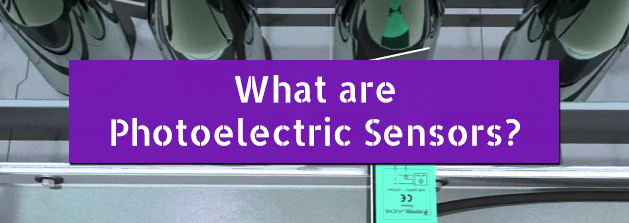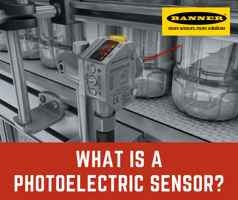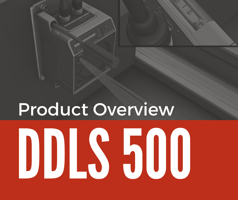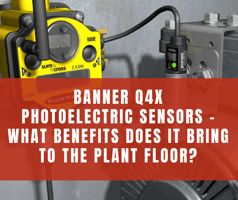There are several industrial applications, especially within manufacturing where the distance,...
What are Photoelectric Sensors?

Photoelectric sensors detect changes in light, consisting of a light source, receiver, a signal convertor, and an amplifier. The receiver (a phototransistor) reads incoming light to confirm that it comes from the sensor’s own lighting component (usually LED). When confirmed, the sensor triggers a pre-defined response.
From this simple concept, photoelectric sensors are incredibly useful for a broad range of industrial safety and automation processes. Seven sensing modes cover the majority of sensing applications, each addressing unique challenges in detecting photoelectric variation.
The Seven Sensing Modes
1. Diffuse
Diffuse photoelectric sensors operate on proximity – meaning that the transmitter and receiver coexist in the same housing, and emit light that triggers a response when an object bounces light back at the receiver. Diffuse sensors are convenient for single-fixture solutions, but work best for short ranges (like automatic sink faucets).
2. Background suppression
Background suppression photoelectric sensors are essentially diffuse sensors, but take the technology a step further by adapting more accurately to challenging object surface properties and different sizes. These sensors use potentiometers to focus on a predetermined range and ignore background reflections, narrowing the possible triggers.
3. Background evaluation
Background evaluation photoelectric sensors are the inverse of background suppression sensors, focusing only on light reflected by the background of a predetermined focal point. These sensors are ideal for applications where the target objects are oddly shaped and may not reliably reflect light back at the sensor.
4. Retroreflective
Retroreflective photoelectric sensors consist of a transmitter and receiver in a single housing. The transmitter component emits light, and when that lights gets bounced back into the receiver by an object interrupting the beam, it triggers the pre-defined response. Retroreflective types have the longest range of photoelectric sensors, and are especially useful in industrial safety systems for large spaces.
5. Clear-object retroreflective
Clear objects can still be detected by this version of retroreflective photoelectric sensors. A low hysteresis circuit can pick up on tiny changes in light associated with clear objects. Polarized filters on both the transmitter and receiver minimize false positives.
6. Thru-beam
This mode uses separate housings for the transmitter and receiver. When a target breaks the beam of light projected between the housings, the response activates. The distance between the transmitter and receiver can be the longest among the sensing modes, making it practical for large spaces without compromising on sensitivity.
7. Measuring Distance
Some photoelectric sensors include built-in measuring technology, such as Multi Pixel Technology (MPT) or Pulse Ranging Technology (PRT). MPT rests on triangulation to determine distance, while PRT tracks the amount of time it takes for a pulse of light to reflect back at the receiver (much like echolocation).
Photoelectric Sensors for Industry 4.0
Photoelectric sensors have been useful tools in the manufacturing world for decades, but with the advent of new, networked technology in Industry 4.0 – sensors must evolve too.
Manufacturers like Pepperl+Fuchs are approaching sensors from new angles to integrate established technology with 4.0 interconnectedness.
Pepperl+Fuchs’ new R100 photoelectric sensor series achieves 4.0 status with innovative I/O Link technology that can send and receive data from higher level information systems. Users can change configurations, run diagnostics, and perform maintenance – even wirelessly, with SmartBridge technology wirelessly connecting R100 sensors to mobile devices.
The R100 series is also the first line of photoelectric sensors to offer all seven sensing modes in one, uniform design. The result is a streamlined, interchangeable solution to any sensing application – with the progressive advantage of Industry 4.0 digital networking.
Choosing Photoelectric Sensors for Your Application
Digitally networked manufacturing continues to shape the rise of Industry 4.0, making more efficient and leaner manufacturing possible. Choosing automation tools that ease the transition can help manufacturers modernize and find cost-effective ways to optimize their processes. One of the support specialists or engineers at ACD can help you decide which sensor will best fit your application:




